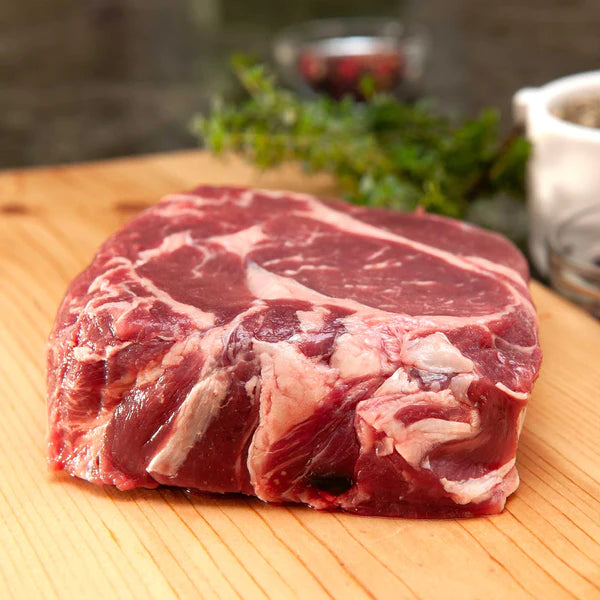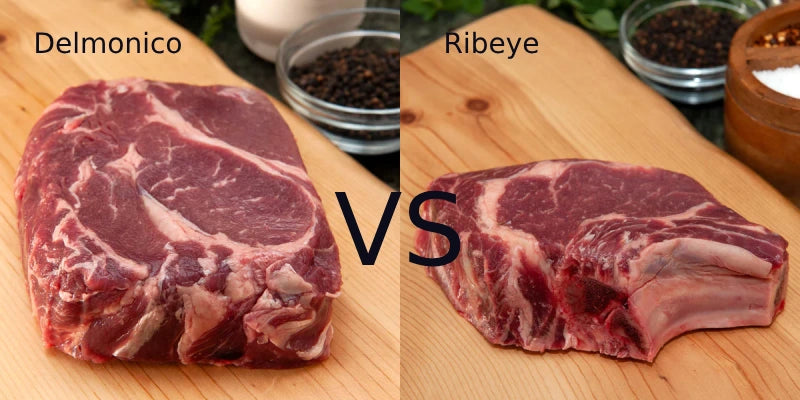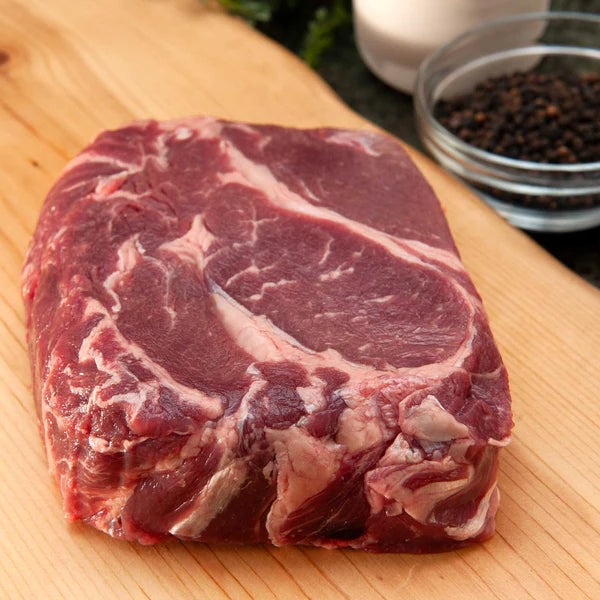Let's talk about a piece of culinary history, as rich and savory as the steak itself—the Delmonico steak. This cut has its roots deeply embedded in the heart of New York City, tracing back to the renowned Delmonico's Restaurant. It's a slice of Americana, offering a taste of the luxury that defined early American dining.

Key Takeaways
- Delmonico Steak Defined: The Delmonico steak is a premium cut of beef known for its rich marbling and buttery tenderness. With origins from the historic Delmonico Restaurant in New York, it’s a slice of Americana on a plate.
- The Delmonico Steak’s Reputation of Excellence: Truly a cut above the rest, the Delmonico Steak has become a hallmark of dining opulence - representing the best a steak can be in both flavor and texture.
- Cooking and Preparation Tips: Buy your Delmonico steak from a reputable source and check for a vibrant red color and significant marbling (make sure you’ve got a real Delmonico on your hands). Methods like grilling, broiling, and pan-searing all work great, and simple seasonings help bring out its strong natural flavors.
What is a Delmonico Steak?
At the heart of its allure is the name itself—Delmonico. It's a nod to an era of dining opulence, originating from Delmonico's Restaurant in New York City, a place that set the gold standard for fine dining in the 19th century. So, what exactly makes a Delmonico steak truly a cut above the rest? It's a question that brings many to the table.
Over the years, "Delmonico steak" has been used to describe several different cuts, each selected by the restaurant's chefs for their supreme quality and uniquely rich marbling that runs throughout the meat. However, from a technical perspective, the Delmonico steak is most popularly recognized as originating from a premium section of beef, specifically at the transition of the 13th rib and the loin area. This special location near the loin means the Delmonico shares its neighborhood with cuts like the New York strip, giving the Delmonico a resemblance to an oversized strip steak. At this juncture of the cow lies a rectangular block of beef that's richly marbled and intensely flavorful. The Delmonico steak cut from butchers like Acabonac Farms is some of the most sought after meat in the world.
A Delmonico steak is celebrated for its rich flavor profile, a result of the perfect amount of fat marbling that ensures each bite is succulent and full of taste. Tender to the point of being almost buttery, this steak doesn't just melt in your mouth, it tells a story.

Is Delmonico a Good Cut of steak?
Yes, the Delmonico Steak is one of the world’s most premium cuts - some may argue that it’s the best. Delmonico steaks are known for their mouthwatering flavor, largely due to the cut's even beef marbling, which melts during cooking, infusing the meat with a juicy, succulent taste. The texture is tender and soft, yet with enough body to provide a satisfying chew. Not to mention, Delmonico steaks are extremely versatile in terms of cooking methods, easily adapted to different recipes, cuisines, and personal preferences. Whether you're looking for a beautifully charred steak off the grill or a pan-seared steak with a rich, caramelized crust, the Delmonico is likely to exceed your expectations.
What is a Delmonico Steak Equivalent To?
Today, the Delmonico name often represents a specific class and quality of meat, depending on the chef's preference and the restaurant's tradition. The cut itself can be likened to several others, depending on who you ask.

Is Delmonico the Same as a Ribeye?
While the Delmonico steak is frequently associated with the ribeye steak, thanks to their similar qualities of marbling and flavor, a true Delmonico is not necessarily the same thing as a ribeye. Both steaks are known for their generous marbling, which is essentially the steak's natural fat weaving throughout the muscle. This marbling is key to creating that melt-in-your-mouth tenderness and rich, beefy flavor. Both are premium meats, and some establishments offer a ribeye named as a Delmonico to signify the extent to which care was taken for the selection and preparation of the meat.
Then there's Delmonico Steak vs. New York strip steak, another common comparison. New York strip, known for its leaner profile but still impressive flavor, shares some qualities with the Delmonico, but offers a slightly firmer bite however. Due to its location near the loin, the Delmonico is harvested near the New York strip cut, which plays further into the confusion.
It is important to understand that the Delmonico steak is a cut that chefs and butchers have taken liberties with over time. In some establishments, a Delmonico might indeed be a ribeye cut, in others, it could lean towards the characteristics of a New York strip. It’s a bit confusing, isn’t it? The underlying implication - it’s the best.
The History of Delmonico Steak
The Delmonico steak's journey from a New York City restaurant to a symbol of fine dining is a fascinating tale. First served in the 19th century at Delmonico's, this steak became synonymous with indulgence. The presence of a Delmonico steak at an establishment was thought of as a reflection of the restaurant's commitment to innovation and the ultimate culinary experience.
Delmonico's, founded by the Delmonico brothers, Giovanni and Pietro, in 1837, was an institution that would set the standard for American dining for decades to come. As Delmonico's Restaurant grew in fame, so did the reputation of its signature steak. The Delmonico steak became synonymous with the finest beef, period. It was not just a meal, it was an experience and a luxury that patrons came to expect from the Delmonico name.
The Debate Around the Cut
If you haven’t noticed yet, there’s quite a lot of debate around what exactly constitutes a Delmonico. Where exactly is it harvested? Can you call other cuts a Delmonico? As mentioned earlier in the article, the Delmonico cut is most commonly harvested at the transition of the 13th rib and the loin area - but out in the culinary wild, the answers you get might not be so cut and dry. The exact location of the cut and its preparation have varied, from restaurant to restaurant, butcher to butcher, over the years. Despite these debates, the steak remains a beloved part of American culinary history, and a symbol of the best a steak can be.
How to Identify a Delmonico Steak
A helpful way to distinguish the Delmonico steak from other premium cuts like the ribeye is to take a look at its size. Delmonico steaks typically stand out due to their substantial heft, often tipping the scales at nearly one pound, while the traditional ribeye usually weighs about half a pound. The thickness of the cut can also give it away. Delmonico steaks push about 2 inches in thickness while ribeyes usually max out at around 1 to 1.5 inches thick.
Also, observe the marbling pattern in the steak. Cuts like the New York strip are also sometimes mistaken for the Delmonico, but the difference is clear when it comes to the ribbons of fat throughout the meat. New York strip steak has a leaner profile with a defined fat edge along one side of the cut. The Delmonico, on the other hand, boasts much thicker marbling that runs evenly throughout the cut.
Overall, look for a thick cut of meat that boasts rich marbling and a vibrant red coloration—qualities that stand out even to the casual observer. Identifying a Delmonico steak can be a bit of an art form, given its variability. When in doubt, a conversation with your butcher can shed light on which cuts they consider worthy of the Delmonico name.

What Does a Delmonico Steak Taste Like?
A Delmonico steak, done right, is a feast for the senses. It’s known for its deep, rich flavor and buttery tenderness. The marbling ensures each bite is succulent, making it a favorite among those who appreciate the finer points of steak.
Is Delmonico Steak Tough?
When properly aged and cooked, a Delmonico steak is anything but tough. The key lies in selecting a quality cut and employing the right cooking techniques to bring out its inherent tenderness.
Is Delmonico Steak Fatty?
The fat content of a Delmonico steak contributes to its flavor and juiciness, making it one of the more indulgent choices. However, this marbling is precisely what allows the steak to remain tender and flavorful throughout the cooking process.

How to Prepare a Delmonico Steak Cut
Preparing a Delmonico steak to perfection is an art, and you don’t wanna go into it blind. This luxurious cut, with its rich marbling and deep flavors, calls for a cooking approach that enhances its inherent qualities. Here's how to do justice to a Delmonico steak, whether you're a seasoned grill master or a home cook looking to knock it out of the park.
The best recipes for cooking Delmonico Steak involve steps to ensure the meat is properly prepared and the right seasonings are selected (the goal is to complement, not overshadow the natural flavors of the cut).
Grilling Delmonico Steak
Grilling is the quintessential method for cooking steaks, offering a smoky flavor and a desirable charred exterior that steak aficionados love.
- Preparation: Start by bringing your Delmonico steak to room temperature for about 30 minutes to ensure even cooking. Lightly oil and generously season both sides with salt and pepper.
- Grill Setup: Preheat your grill to high heat. If you're using charcoal, aim for a two-zone setup with a hot zone for searing and a cooler zone for more gentle cooking.
- Cooking: Sear the steak over direct high heat for about 2-3 minutes per side to develop a rich, caramelized crust. Move it to the cooler part of the grill and continue cooking to your preferred doneness, usually 2-5 minutes more per side depending on thickness and desired internal temperature.
- Resting: Let the steak rest for at least 5 minutes before slicing. This allows the juices to redistribute, ensuring each bite is moist and flavorful.
Broiling Delmonico Steak
Broiling mimics the high heat of grilling, using the top-down heat of an oven's broiler to create a succulent steak with a delicious crust.
- Preparation: Bring the steak to room temperature and season it well. Preheat your broiler to high and position the oven rack so that the steak will be 3-4 inches from the heat source.
- Broiling Pan: Place the steak on a preheated broiler pan or a rack over a baking sheet to catch drips. This setup helps air circulate around the steak, cooking it more evenly.
- Cooking: Broil the steak for about 4-6 minutes per side, depending on thickness and desired doneness. Keep the oven door ajar to prevent the broiler from cycling off and to keep an eye on the steak to prevent charring.
- Resting: Allow the steak to rest for 5 minutes after cooking. This rest period is crucial for a juicy, tender steak.
Pan-Searing Delmonico Steak
Pan-searing is ideal for achieving a flavorful crust with a tender and juicy interior, perfect for an indoor cooking option.
- Preparation: Bring the steak to room temperature. Heat a heavy skillet, preferably cast iron, over high heat until very hot. Season the steak generously with salt and pepper.
- Searing: Add a small amount of high-smoke-point oil to the pan, then place the steak in the skillet. Sear for about 3-4 minutes on one side until a golden-brown crust forms. Flip the steak and sear the other side.
- Finishing: For a medium-rare finish, continue cooking in the pan, frequently flipping for an even crust, until the desired doneness is reached—about 135°F (57°C) for medium-rare. Optionally, for thicker cuts, you can finish the steak in a 375°F (190°C) oven for a more gentle cook.
- Resting: Let the steak rest on a warm plate for at least 5 minutes before cutting into it.
What to Eat with a Delmonico Steak
Complement a Delmonico steak with sides that match its richness—think creamy mashed potatoes, grilled asparagus, or a bold Caesar salad. For a perfect pairing, try our Delmonico steak grill recipe featuring a fall Spice Rub with Sweet Potato & Arugula Salad. A full-bodied red wine rounds out the dining experience, elevating the steak to new heights.
How to Choose a Delmonico Steak
When selecting a Delmonico steak, look for vibrant red color, substantial marbling that runs throughout the cut evenly, and a fresh scent. These indicators, along with a trusted butcher's advice, can guide you to the best choice. It’s important to source your Delmonico steak from a supplier with cattle raised on a nutritious, natural diet that ensures the richest of flavor.
100% Grass-Fed Delmonico Steak from Acabonac Farms
Acabonac Farms’ cattle live exclusively on green grassy pastures and are raised with no antibiotics, fillers, or hormones - just the way the original Delmonico steak was meant to be. Interested in getting this elusive, one-of-a-kind steak delivered right to your front door?
Acabonac Farms offers 100% grass-fed Delmonico steak, bringing a new level of flavor and nutrition to this historic cut.
Frequently Asked Questions About Delmonico Steaks
What makes a Delmonico steak different from other steaks?
The Delmonico steak distinguishes itself through a combination of its storied history, exceptional flavor, and culinary flexibility. The rich flavor profile of a Delmonico steak, characterized by its marbling and tenderness, sets it apart from other steaks. Its versatility also stands out, as it can be prepared deliciously in a wide variety of ways.
Why is there confusion about the Delmonico steak cut?
The confusion surrounding the Delmonico steak stems from its evolution over time. Originally tied to Delmonico's Restaurant, the term "Delmonico steak" has been used to refer to different cuts of beef, depending on the region, the butcher, or the chef preparing it.
How do I cook Delmonico steak at home?
The best methods to cook a Delmonico steak—grilling and broiling—maximize its flavor and texture. Grilling over high heat allows for a smoky char and a savory crust to form, encapsulating the steak's juicy interior. Broiling, similarly, applies intense top-down heat to sear the steak, creating a delicious crust while keeping the inside tender and flavorful.
Can I find Delmonico steak outside of New York City?
Yes. While the specific cut associated with the Delmonico name may vary from one place to another, the emphasis on quality and flavor remains constant.
What are the best seasonings for a Delmonico steak?
The steak's inherent richness and taste are best accentuated by simple seasonings like a Fall Rub — but it can be as simple as salt and freshly ground pepper. The minimalist approach allows the steak's natural flavors to shine.
